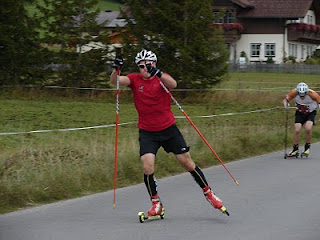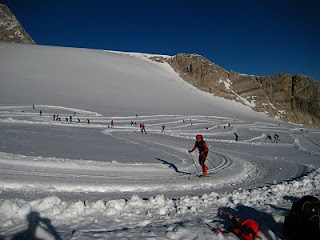Lappe Nordic Newsletter Article
While writing this article I am currently in Schladming, Austria with the Thunder Bay National Development Centre for a 3 week training camp. The focus of our camp is skiing on the Dachstein Glacier at 2700m. We are able to live at a lower altitude by staying in Schladming which is a small town in the bottom of a valley below the glacier. By living at a lower altitude we are able to recover faster and still achieve the physiological benefits of training at a high altitude. The other benefit of living at a low altitude is we are better able to do dry-land training including intensity workouts during the afternoons. Ramsau, another small town above the valley Schladming sits in, has some great roads and a twisty rollerski track which provides an excellent location for afternoon rollerski workouts.

Warming up for a rollerski intensity session in Ramsau.
It’s an early morning on ski days, waking up at 6:30am so we can drive 25 minutes up switchbacks to the tram station where we hop on a gondola to take us over the face of the mountain to the main building on top. The early mornings are well worth it though. After the spectacular gondola ride we are greeted by a 7.5km freshly groomed track with views of mountains disappearing into the horizon. Shortly after arriving in Austria the Dachstein Glacier received about a foot of fresh snow. With all the new snow skiing conditions are comparable to mid-winter. On some occasions we have even used hard-wax for classic skiing! Because the Dachstein Glacier is such a great place for skiing during the off-season months it attracts many top European teams including many World Cup athletes. It’s pretty cool to ski alongside the big names in cross-country skiing like Ola Vigen Hattestad and Petra Majdic.

A view of part of the long course on the Dachstein Glacier.

Happy to have skis back on my feet.
Our accommodation in Schladming consists of apartment style buildings in Haus Katarina. During our down time we have a ping-pong table to keep us entertained. Of course, exploring the town is always a good option too with many bakeries and shops worth checking out. We have a half-pension deal with Haus Katarina, meaning we cook our own lunches while breakfast is served buffet style at Haus Katarina and dinners are at a restaurant across the street called the Wintergarten. If you ever get the chance to travel to Austria, one local dessert you have to try is Kaiserschmarren. It tastes similar to Finnish pancakes except it’s thicker and cut into small square pieces served with raisins, icing sugar and a bowl of fruit sauce for your dipping pleasure. Caution, it is generally served in large portions and it is very filling!
Traveling to new places for challenging training camps is a lot of fun, but it can also be a good recipe for sickness and burnout if one is not careful. The fall season combined with school starting up again can have the same effect. To have the best fall training possible and bring you into prime race shape for the winter here are a few tips I do my best to follow:
1. Consistency. It is important to manage your energy so you can complete each training session with good quality. If you are starting to get tired, slow down during your next few zone 1 workouts. Avoid running yourself down too badly as you will run a higher risk of catching a virus.
2. Stay healthy. Viruses are common in the fall months, especially for students spending many hours in classrooms where germs are everywhere. The easiest way to avoid sickness is to sleep lots and wash your hands regularly. When I am training hard I operate well on 9 hours of sleep at night and a 1 hour nap in the afternoon. Vitamins, Cold FX and healthy eating habits will also help. If you feel your throat starting to get a little scratchy, gargle warm salt water to kill the bacteria before it gets any worse.
3. Stay loose and avoid injury. Stretching is the best and easiest way to accomplish this. I like to stretch for half an hour directly before bed while listening to music. If you find stretching just isn’t enough then a visit to a massage therapist might be a good idea.
4. Post training recovery. Your recovery directly following a workout is almost as important as the workout itself. Always have a full change of clothes to avoid getting chilled. It is important to get some protein and carbohydrates in right away. I use the National Ski Team recovery drink mix which can be ordered through CCC. Basically any whey based drink will do the trick. Milk is also a great post workout drink. I prefer chocolate milk personally. Water is only sufficient if you also have some food to go with it.
Good luck with your fall training and I’ll see you on the trails when the snow flies!
Michael

Warming up for a rollerski intensity session in Ramsau.
It’s an early morning on ski days, waking up at 6:30am so we can drive 25 minutes up switchbacks to the tram station where we hop on a gondola to take us over the face of the mountain to the main building on top. The early mornings are well worth it though. After the spectacular gondola ride we are greeted by a 7.5km freshly groomed track with views of mountains disappearing into the horizon. Shortly after arriving in Austria the Dachstein Glacier received about a foot of fresh snow. With all the new snow skiing conditions are comparable to mid-winter. On some occasions we have even used hard-wax for classic skiing! Because the Dachstein Glacier is such a great place for skiing during the off-season months it attracts many top European teams including many World Cup athletes. It’s pretty cool to ski alongside the big names in cross-country skiing like Ola Vigen Hattestad and Petra Majdic.
A view of part of the long course on the Dachstein Glacier.

Happy to have skis back on my feet.
Our accommodation in Schladming consists of apartment style buildings in Haus Katarina. During our down time we have a ping-pong table to keep us entertained. Of course, exploring the town is always a good option too with many bakeries and shops worth checking out. We have a half-pension deal with Haus Katarina, meaning we cook our own lunches while breakfast is served buffet style at Haus Katarina and dinners are at a restaurant across the street called the Wintergarten. If you ever get the chance to travel to Austria, one local dessert you have to try is Kaiserschmarren. It tastes similar to Finnish pancakes except it’s thicker and cut into small square pieces served with raisins, icing sugar and a bowl of fruit sauce for your dipping pleasure. Caution, it is generally served in large portions and it is very filling!
Traveling to new places for challenging training camps is a lot of fun, but it can also be a good recipe for sickness and burnout if one is not careful. The fall season combined with school starting up again can have the same effect. To have the best fall training possible and bring you into prime race shape for the winter here are a few tips I do my best to follow:
1. Consistency. It is important to manage your energy so you can complete each training session with good quality. If you are starting to get tired, slow down during your next few zone 1 workouts. Avoid running yourself down too badly as you will run a higher risk of catching a virus.
2. Stay healthy. Viruses are common in the fall months, especially for students spending many hours in classrooms where germs are everywhere. The easiest way to avoid sickness is to sleep lots and wash your hands regularly. When I am training hard I operate well on 9 hours of sleep at night and a 1 hour nap in the afternoon. Vitamins, Cold FX and healthy eating habits will also help. If you feel your throat starting to get a little scratchy, gargle warm salt water to kill the bacteria before it gets any worse.
3. Stay loose and avoid injury. Stretching is the best and easiest way to accomplish this. I like to stretch for half an hour directly before bed while listening to music. If you find stretching just isn’t enough then a visit to a massage therapist might be a good idea.
4. Post training recovery. Your recovery directly following a workout is almost as important as the workout itself. Always have a full change of clothes to avoid getting chilled. It is important to get some protein and carbohydrates in right away. I use the National Ski Team recovery drink mix which can be ordered through CCC. Basically any whey based drink will do the trick. Milk is also a great post workout drink. I prefer chocolate milk personally. Water is only sufficient if you also have some food to go with it.
Good luck with your fall training and I’ll see you on the trails when the snow flies!
Michael
Comments